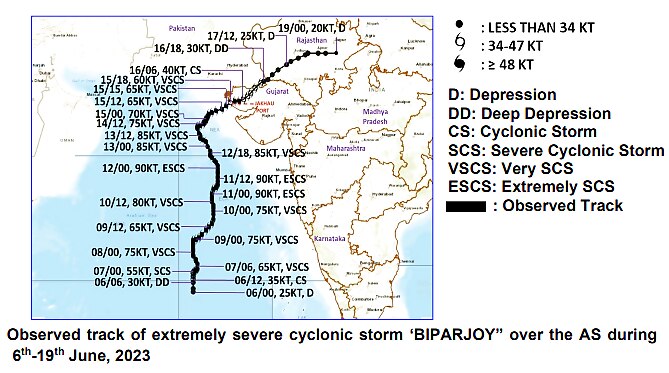
views
Cyclone Biparjoy which hit the Gujarat coast this June had changed its path almost nine times making it difficult for meteorologists to predict its final path, according to the India Meteorological Department (IMD).
The cyclone had formed in the Arabian Sea on the evening of June 6 and continued to intensify until its landfall on the Gujarat coast on June 15 as a very severe storm. It barrelled into the Saurashtra and Kutch coast close to Jakhau Port with maximum sustained winds of 115-125 kmph gusting to 140 kmph, causing widespread damage in the coastal districts.
“The cyclone changed its path about nine times, resulting in relatively higher difficulty in predicting the path of the cyclone,” said IMD in its detailed post-event report. Scientists say the system was being pulled in opposing directions by the two driving anticyclones present over central India and Arabian Peninsula.

The weather department which gives out a five-day forecast had not indicated any landfall until June 11 when it issued its first cyclone watch for Saurashtra and Kutch coast in Gujarat. Though the cyclone continued to evolve and picked up intensity twice in a day, the IMD was able to predict its landfall well on time, enabling the local administration to minimise loss of lives.
Longest duration cyclone in 46 years
One of the first cyclones to form in the Arabian Sea, Cyclone Biparjoy was also one of the longest-duration cyclones in the Indian Ocean ever. The last such storm developed over Bay of Bengal in November 1977, which lasted for about 14 days and six hours.
Biparjoy moved very slowly during its lifetime with an average speed of 7.7 kmph against the usual speed of 15 kmph for very severe cyclones over the Arabian Sea during the monsoon. It lasted for about 13 days and three hours during which it changed its track nine times. This was far beyond the average life period of about six days that very severe cyclonic storms usually maintain in the Arabian Sea during monsoon season based on the data during 1990-2013.
Longevity of Kyarr and Gaja
The last time the Arabian Sea saw such a long-lasting cyclone was in October 2019 when it churned out extremely severe Cyclone Kyarr. Kyarr too had multiple re-curvatures, but it had weakened in the sea. Very Severe Cyclonic Storm Gaja that formed in November 2018 over southeast Bay of Bengal too had a life period of nine days and 15 hours. It crossed the southern peninsular region, emerged into Arabian Sea and weakened over southwest and adjoining southeast Arabian Sea.
Out of the total 66 cyclonic storms that have formed in the Arabian Sea during 1965-2022, only eight have crossed Gujarat coast.



















Comments
0 comment